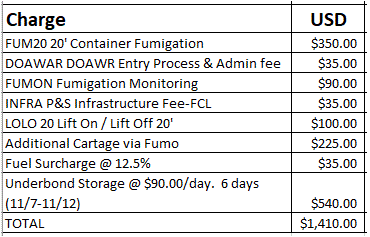|
|
Before booking your shipment, you can use the online freight calculator above to estimate your international shipping cost quickly. It's a fast and straightforward way to get started with shipping from the USA, especially if you're sending cargo to Australia, New Zealand, or elsewhere in Oceania.
Fumigation Certificate for Shipping from the USA to Australia and New Zealand
If your cargo is bound for Australia or New Zealand, there’s an important requirement you can’t overlook: fumigation. These countries enforce strict quarantine regulations to stop the spread of the Brown Marmorated Stink Bug (BMSB)—a destructive agricultural pest. If your shipment doesn’t meet these regulations, it won’t be allowed to move forward.

This applies to all international shipping companies moving freight to, through, or transiting either country, and similar rules are enforced across parts of Oceania as well.
Seasonal Fumigation Requirements
During the BMSB risk season, from September 1 to April 30, any cargo from the U.S. to Australia or New Zealand must be fumigated. These rules apply regardless of whether your shipment is commercial cargo or personal effects.
Before the cargo is loaded for international shipping, your ocean freight carrier must receive a copy of the fumigation certificate. At the destination, the original certificate will be required for Customs clearance. No valid certificate? No cargo release.
To ensure you're meeting the latest import requirements, it's best to check the official resources:
- For Australia, visit the DAWR website
- For New Zealand, visit the MPI site
Fumigation vs. ISPM15: What’s the Difference?
It's easy to confuse fumigation requirements with ISPM15 wood-packing rules, but they’re not the same.
ISPM15 applies to all shipments leaving the United States that use wooden pallets, crates, or dunnage. These items must be heat-treated and stamped with a certification mark.
BMSB treatment, on the other hand, is mandatory only for shipments to Australia and New Zealand during the risk season. It applies to the cargo as a whole, not just the packaging.
If your goods aren’t fumigated as required, your carrier won’t load your shipment. And since global cargo transportation companies must comply with the destination country's biosecurity laws, they can't make exceptions. The responsibility rests with you as the shipper.
The Treatment Options and Costs
To simplify the process, many cargo consolidators now offer fumigation services directly at their container freight station (CFS) terminals. Here's how it typically works:
- The treatment is done before loading or at a transshipment sea port
- Cost is about $30 per weight/measurement (w/m)
- There’s a minimum fee, usually $200–$300, depending on the carrier
The benefit of using the carrier’s fumigation service is that it's already integrated into your international shipping cost, and the carrier assumes responsibility for any compliance issues. If something goes wrong, the liability is theirs, not yours. This makes it a reliable choice for those looking for affordable international shipping without compliance headaches.
What If You Fumigate Yourself?
You’re allowed to handle the treatment on your own, but be cautious. If you choose this route, you’ll need to:
- Provide a copy of the fumigation certificate before delivery to the CFS
- Present the original certificate for Customs clearance at the destination
Ensure your provider is certified and that the document is correctly formatted. If the certificate is rejected or missing critical information, you could face:
- Fines of over $1,000
- Extra fees for re-treatment or storage
- Cargo delays, returns, or even destruction
That’s why using your international shipping company’s built-in fumigation option is often the safest route.
A Real Example: Why It Matters
Here’s an actual case from a shipment to Australia:
"The fumigation certificate had some mistakes. We finished fumigating over the weekend, and Quarantine finally cleared the container today. You should be able to unpack and pick up the cargo in a day or two. Just a heads-up: the freight won’t be released until the charges are paid."

In this case, errors in the paperwork delayed clearance and resulted in additional fees. It serves as a reminder of the importance of meeting fumigation requirements before cargo departs from the United States.
Summary
If you're shipping from the USA to Australia or New Zealand, fumigation is not optional—it’s a legal requirement. Whether you're working with an experienced global cargo transportation company or arranging everything yourself, be sure to:
- Know the BMSB season dates
- Choose a certified treatment provider
- Budget for the added international shipping cost
- Double-check your paperwork to avoid delays
Proper planning can help you stay compliant, avoid fines, and enjoy smoother, more affordable international shipping to Oceania.


.png)


